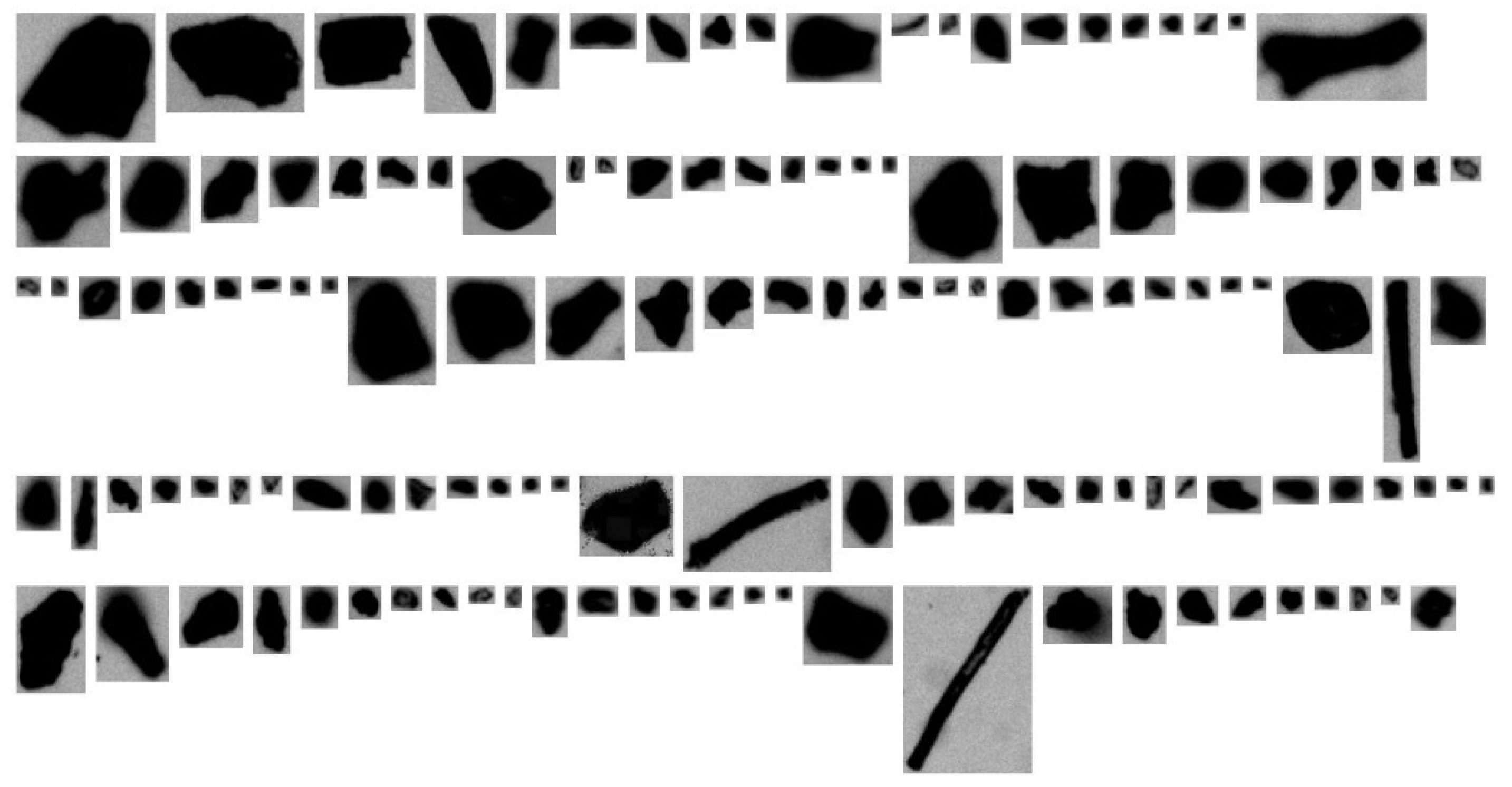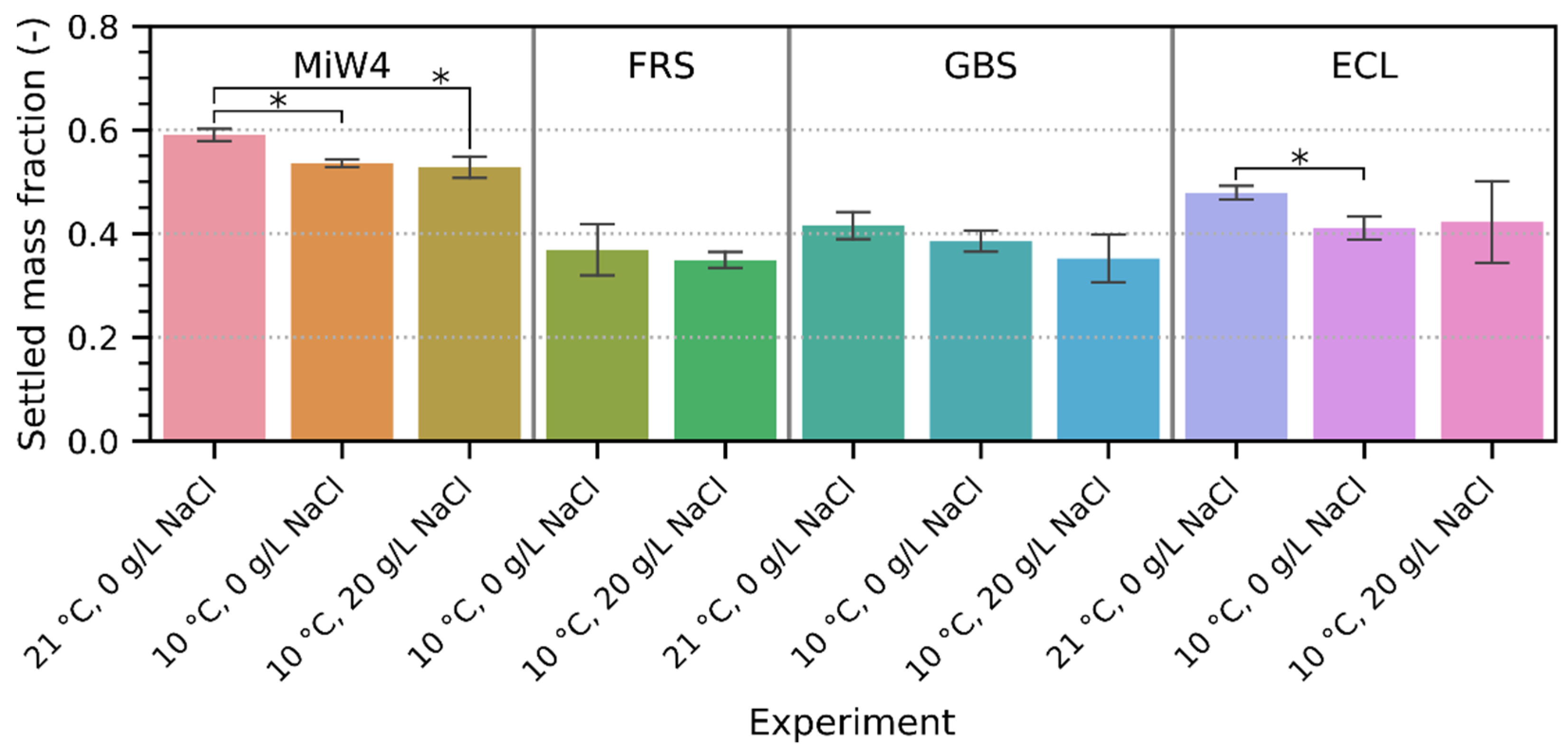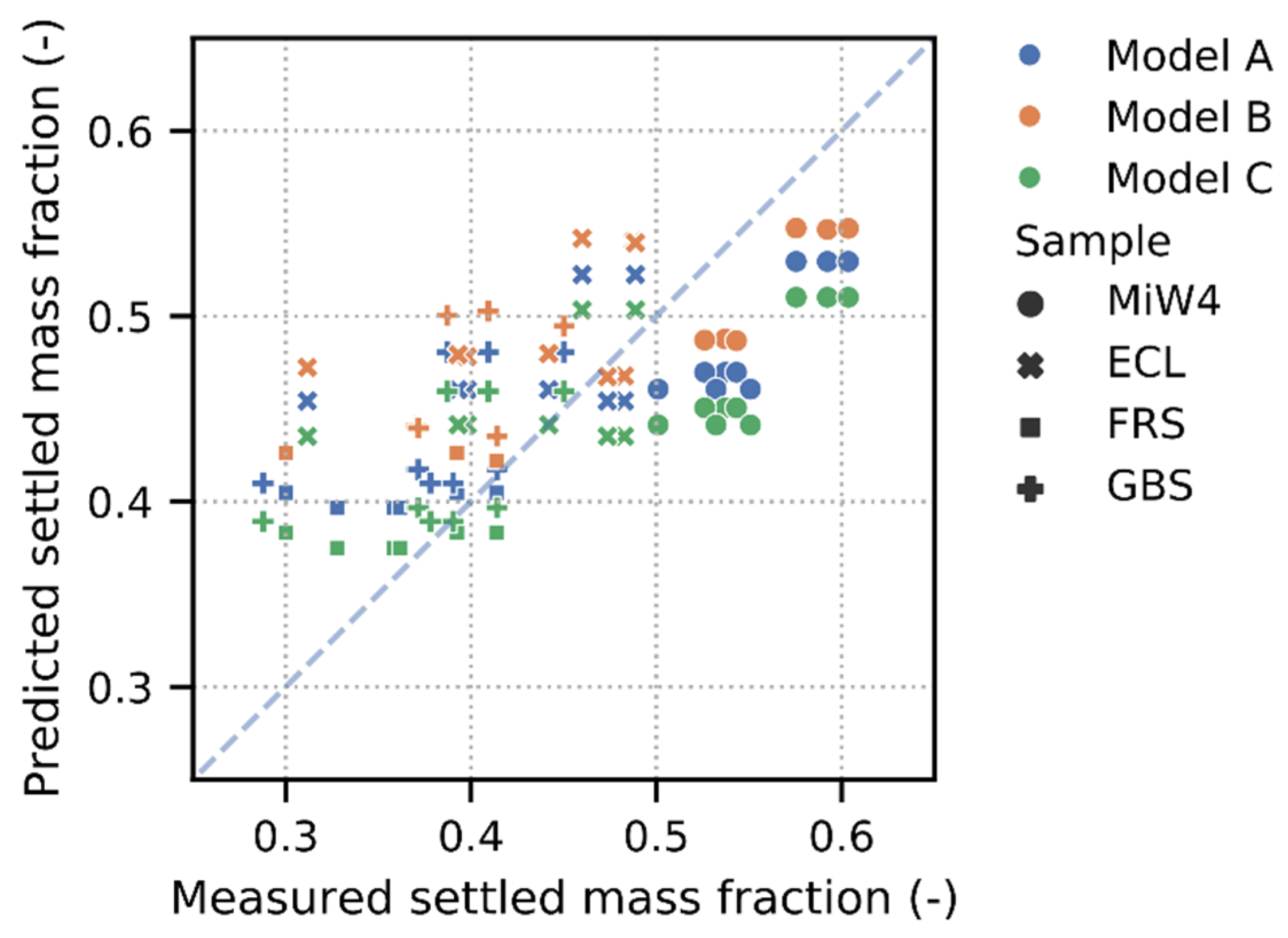Settling of Road-Deposited Sediment: Influence of Particle Density, Shape, Low Temperatures, and Deicing Salt
Abstract
:1. Introduction
2. Materials and Methods
2.1. Materials—Study Site and Characterization
2.2. Settling Experiments
2.3. Modeling of Settling Experiments
- Model A: Spherical particles
- Model B: Spherical particles with consideration of the withdrawn sample volume
- Model C: Nonspherical particles
2.3.1. Model A: Spherical Particles
2.3.2. Model B: Spherical Particles with Consideration of the Withdrawn Sample Volume
2.3.3. Model C: Nonspherical Particles
2.4. Statistics
3. Results and Discussion
3.1. Particle Size and Shape
3.2. Particle Density with Respect to Particle Size
3.3. Settling Experiments
3.4. Validation of Settling Model
4. Conclusions
Supplementary Materials
Author Contributions
Funding
Acknowledgments
Conflicts of Interest
Nomenclature
| Symbol | Description |
| AR | Aspect ratio |
| CD | Drag coefficient |
| CFD | Computational fluid dynamics |
| d | Particle diameter |
| d* | Dimensionless particle diameter |
| Dc | Diameter of the smallest circumscribed circle |
| deq | Area equivalent circle diameter |
| Di | Diameter of the largest inscribed circle |
| g | Acceleration due to gravity |
| LOI | Loss on ignition |
| PM | Particulate matter |
| PSD | Particle size distribution |
| RDS | Road deposited sediment |
| SCM | Stormwater control measure |
| SQID | Stormwater quality improvement device |
| t | Temperature of the fluid |
| w | Terminal settling velocity |
| w* | Dimensionless settling velocity |
| wNaCl | Mass fraction of the NaCl in the fluid |
| ηf | Dynamic viscosity of fluid |
| νf | Kinematic viscosity of fluid |
| ρf | Fluid density |
| ρs | Particle density |
| ϕ | Particle sphericity |
| φRiley | Riley circularity |
References
- Stone, M.; Marsalek, J. Trace metal composition and speciation in street sediment: Sault Ste. Marie, Canada. Water Air Soil Pollut. 1996, 87, 149–169. [Google Scholar] [CrossRef]
- Sutherland, R.A.; Tolosa, C.A. Multi-element analysis of road-deposited sediment in an urban drainage basin, Honolulu, Hawaii. Environ. Pollut. 2000, 110, 483–495. [Google Scholar] [CrossRef]
- Sutherland, R.A.; Tack, F.M.G.; Ziegler, A.D. Road-deposited sediments in an urban environment: A first look at sequentially extracted element loads in grain size fractions. J. Hazard. Mater. 2012, 225–226, 54–62. [Google Scholar] [CrossRef] [PubMed]
- Loganathan, P.; Vigneswaran, S.; Kandasamy, J. Road-Deposited Sediment Pollutants: A Critical Review of their Characteristics, Source Apportionment, and Management. Crit. Rev. Environ. Sci. Technol. 2013, 43, 1315–1348. [Google Scholar] [CrossRef]
- Murakami, M.; Nakajima, F.; Furumai, H. Size- and density-distributions and sources of polycyclic aromatic hydrocarbons in urban road dust. Chemosphere 2005, 61, 783–791. [Google Scholar] [CrossRef] [PubMed]
- Zgheib, S.; Moilleron, R.; Saad, M.; Chebbo, G. Partition of pollution between dissolved and particulate phases: What about emerging substances in urban stormwater catchments? Water Res. 2011, 45, 913–925. [Google Scholar] [CrossRef] [PubMed]
- Dierkes, C.; Lucke, T.; Helmreich, B. General Technical Approvals for Decentralised Sustainable Urban Drainage Systems (SUDS)—The Current Situation in Germany. Sustainability 2015, 7, 3031–3051. [Google Scholar] [CrossRef] [Green Version]
- Goonetilleke, A.; Lampard, J.-L. Chapter 3—Stormwater Quality, Pollutant Sources, Processes, and Treatment Options. In Approaches to Water Sensitive Urban Design; Sharma, A.K., Gardner, T., Begbie, D., Eds.; Woodhead Publishing: Cambridge, UK, 2019; pp. 49–74. ISBN 978-0-12-812843-5. [Google Scholar]
- Rommel, S.H.; Helmreich, B. Influence of Temperature and De-Icing Salt on the Sedimentation of Particulate Matter in Traffic Area Runoff. Water 2018, 10, 1738. [Google Scholar] [CrossRef] [Green Version]
- Roseen, R.M.; Ballestero, T.P.; Houle, J.J.; Avellaneda, P.; Briggs, J.; Fowler, G.; Wildey, R. Seasonal Performance Variations for Storm-Water Management Systems in Cold Climate Conditions. J. Environ. Eng. 2009, 135, 128–137. [Google Scholar] [CrossRef]
- Semadeni-Davies, A. Winter performance of an urban stormwater pond in southern Sweden. Hydrol. Process. 2006, 20, 165–182. [Google Scholar] [CrossRef]
- Torres, A.; Bertrand-Krajewski, J.-L. Evaluation of uncertainties in settling velocities of particles in urban stormwater runoff. Water Sci. Technol. 2008, 57, 1389–1396. [Google Scholar] [CrossRef] [Green Version]
- Kang, J.; Li, Y.; Lau, S.; Kayhanian, M.; Stenstrom, M. Particle Destabilization in Highway Runoff to Optimize Pollutant Removal. J. Environ. Eng. 2007, 133, 426–434. [Google Scholar] [CrossRef]
- Gunawardana, C.; Egodawatta, P.; Goonetilleke, A. Role of particle size and composition in metal adsorption by solids deposited on urban road surfaces. Environ. Pollut. 2014, 184, 44–53. [Google Scholar] [CrossRef] [PubMed] [Green Version]
- Kayhanian, M.; McKenzie, E.R.; Leatherbarrow, J.E.; Young, T.M. Characteristics of road sediment fractionated particles captured from paved surfaces, surface run-off and detention basins. Sci. Total Environ. 2012, 439, 172–186. [Google Scholar] [CrossRef]
- McKenzie, E.; Wong, C.; Green, P.; Kayhanian, M.; Young, T. Size dependent elemental composition of road-associated particles. Sci. Total Environ. 2008, 398, 145–153. [Google Scholar] [CrossRef] [Green Version]
- Gelhardt, L.; Huber, M.; Welker, A. Development of a Laboratory Method for the Comparison of Settling Processes of Road-Deposited Sediments with Artificial Test Material. WaterAir Soil Pollut. 2017, 228, 467. [Google Scholar] [CrossRef]
- Li, Y.; Lau, S.-L.; Kayhanian, M.; Stenstrom, M.K. Particle size distribution in highway runoff. J. Environ. Eng. 2005, 131, 1267–1276. [Google Scholar] [CrossRef]
- Li, Y.; Lau, S.; Kayhanian, M.; Stenstrom, M. Dynamic Characteristics of Particle Size Distribution in Highway Runoff: Implications for Settling Tank Design. J. Environ. Eng. 2006, 132, 852–861. [Google Scholar] [CrossRef]
- Kayhanian, M.; Rasa, E.; Vichare, A.; Leatherbarrow, J. Utility of Suspended Solid Measurements for Storm-Water Runoff Treatment. J. Environ. Eng. 2008, 134, 712–721. [Google Scholar] [CrossRef]
- Li, Y.; Kang, J.-H.; Lau, S.-L.; Kayhanian, M.; Stenstrom, M.K. Optimization of settling tank design to remove particles and metals. J. Environ. Eng. 2008, 134, 885–894. [Google Scholar] [CrossRef] [Green Version]
- Spelman, D.; Sansalone, J.J. Is the Treatment Response of Manufactured BMPs to Urban Drainage PM Loads Portable? J. Environ. Eng. 2018, 144, 04018013. [Google Scholar] [CrossRef]
- Lin, H.; Ying, G.; Sansalone, J. Granulometry of Non-colloidal Particulate Matter Transported by Urban Runoff. Water Air Soil Pollut. 2009, 198, 269–284. [Google Scholar] [CrossRef]
- Laliberté, M.; Cooper, W.E. Model for calculating the density of aqueous electrolyte solutions. J. Chem. Eng. Data 2004, 49, 1141–1151. [Google Scholar] [CrossRef]
- Laliberté, M. Model for Calculating the Viscosity of Aqueous Solutions. J. Chem. Eng. Data 2007, 52, 321–335. [Google Scholar] [CrossRef]
- Hettler, E.N.; Gulliver, J.S.; Kayhanian, M. An elutriation device to measure particle settling velocity in urban runoff. Sci. Total Environ. 2011, 409, 5444–5453. [Google Scholar] [CrossRef] [PubMed]
- Aiguier, E.; Chebbo, G.; Bertrand-Krajewski, J.-L.; Hedgest, P.; Tyack, N. Methods for determining the settling velocity profiles of solids in storm sewage. Water Sci. Technol. 1996, 33, 117–125. [Google Scholar] [CrossRef]
- Michelbach, S.; Wöhrle, C. Settleable solids in a combined sewer system, settling characteristics, heavy metals, efficiency of storm water tanks. Water Sci. Technol. 1993, 27, 153–164. [Google Scholar] [CrossRef]
- Ying, G.; Sansalone, J. Gravitational Settling Velocity Regimes for Heterodisperse Urban Drainage Particulate Matter. J. Environ. Eng. 2011, 137, 15–27. [Google Scholar] [CrossRef]
- Blott, S.J.; Pye, K. Particle shape: A review and new methods of characterization and classification. Sedimentology 2008, 55, 31–63. [Google Scholar] [CrossRef]
- Breakey, D.E.S.; Vaezi, G.F.; Masliyah, J.H.; Sanders, R.S. Side-view-only determination of drag coefficient and settling velocity for non-spherical particles. Powder Technol. 2018, 339, 182–191. [Google Scholar] [CrossRef]
- Connolly, B.J.; Loth, E.; Smith, C.F. Shape and drag of irregular angular particles and test dust. Powder Technol. 2020, 363, 275–285. [Google Scholar] [CrossRef]
- Wang, Y.; Zhou, L.; Wu, Y.; Yang, Q. New simple correlation formula for the drag coefficient of calcareous sand particles of highly irregular shape. Powder Technol. 2018, 326, 379–392. [Google Scholar] [CrossRef]
- Bagheri, G.; Bonadonna, C. On the drag of freely falling non-spherical particles. Powder Technol. 2016, 301, 526–544. [Google Scholar] [CrossRef] [Green Version]
- DIBt. Teil 1: Anlagen zur dezentralen Behandlung des Abwassers von Kfz-Verkehrsflächen zur anschließenden Versickerung in Boden und Grundwasser; Zulassungsgrundsätze Niederschlagswasserbehandlungsanlagen; Deutsches Institut für Bautechnik: Berlin, Germany, 2017. [Google Scholar]
- Dierkes, C.; Welker, A.; Dierschke, M. Development of testing procedures for the certification of decentralized stormwater treatment facilities—Results of laboratory tests. NOVATECH 2013, 2013, 1–10. [Google Scholar]
- Riley, N.A. Projection sphericity. J. Sediment. Res. 1941, 11, 94–95. [Google Scholar]
- Bagheri, G.H.; Bonadonna, C.; Manzella, I.; Vonlanthen, P. On the characterization of size and shape of irregular particles. Powder Technol. 2015, 270, 141–153. [Google Scholar] [CrossRef]
- Huber, M.; Welker, A.; Drewes, J.E.; Helmreich, B. Auftausalze im Straßenwinterdienst-Aufkommen und Bedeutung für dezentrale Behandlungsanlagen von Verkehrsflächenabflüssen zur Versickerung. Abwasser 2015, 156, 1138–1152. [Google Scholar]
- Hilliges, R.; Endres, M.; Tiffert, A.; Brenner, E.; Marks, T. Characterization of road runoff with regard to seasonal variations, particle size distribution and the correlation of fine particles and pollutants. Water Sci. Technol. 2017, 75, 1169–1176. [Google Scholar] [CrossRef] [Green Version]
- American Public Health Association; American Water Works Association; Water Environment Federation (Eds.) Standard Methods for the Examination of Water and Wastewater; American Public Health Association: Washington, DC, USA, 2017; ISBN 978-0-87553-287-5. [Google Scholar]
- Virtanen, P.; Gommers, R.; Oliphant, T.E.; Haberland, M.; Reddy, T.; Cournapeau, D.; Burovski, E.; Peterson, P.; Weckesser, W.; Bright, J.; et al. SciPy 1.0: Fundamental algorithms for scientific computing in python. Nat. Methods 2020, 17, 261–272. [Google Scholar] [CrossRef] [Green Version]
- The Pandas Development Team. Pandas-Dev/Pandas: Pandas; Zenodo: Geneva, Switzerland, 2020. [Google Scholar]
- Hunter, J.D. Matplotlib: A 2D graphics environment. Comput. Sci. Eng. 2007, 9, 90–95. [Google Scholar] [CrossRef]
- Waskom, M.; Botvinnik, O.; Ostblom, J.; Gelbart, M.; Lukauskas, S.; Hobson, P.; Gemperline, D.C.; Augspurger, T.; Halchenko, Y.; Cole, J.B.; et al. Mwaskom/Seaborn: v0.10.1 (April 2020); Zenodo: Geneva, Switzerland, 2020. [Google Scholar]
- Lee, D.H.; Min, K.S.; Kang, J.-H. Performance evaluation and a sizing method for hydrodynamic separators treating urban stormwater runoff. Water Sci. Technol. 2014, 69, 2122–2131. [Google Scholar] [CrossRef]
- Selbig, W.R.; Fienen, M.N. Regression Modeling of Particle Size Distributions in Urban Storm Water: Advancements through Improved Sample Collection Methods. J. Environ. Eng. 2012, 138, 1186–1193. [Google Scholar] [CrossRef]
- Haider, A.; Levenspiel, O. Drag coefficient and terminal velocity of spherical and nonspherical particles. Powder Technol. 1989, 58, 63–70. [Google Scholar] [CrossRef]
- Cheng, N.-S. Comparison of formulas for drag coefficient and settling velocity of spherical particles. Powder Technol. 2009, 189, 395–398. [Google Scholar] [CrossRef]
- Chhabra, R.P.; Agarwal, L.; Sinha, N.K. Drag on non-spherical particles: An evaluation of available methods. Powder Technol. 1999, 101, 288–295. [Google Scholar] [CrossRef]
- Pedregosa, F.; Varoquaux, G.; Gramfort, A.; Michel, V.; Thirion, B.; Grisel, O.; Blondel, M.; Prettenhofer, P.; Weiss, R.; Dubourg, V.; et al. Scikit-learn: Machine learning in Python. J. Mach. Learn. Res. 2011, 12, 2825–2830. [Google Scholar]
- Seabold, S.; Perktold, J. statsmodels: Econometric and statistical modeling with python. In Proceedings of the 9th python in science conference, Austin, TX, USA, 28 June–3 July 2010. [Google Scholar]
- Kayhanian, M.; Givens, B. Processing and analysis of roadway runoff micro (<20 μm) particles. J. Environ. Monit. 2011, 13, 2720–2727. [Google Scholar]
- Kreider, M.L.; Panko, J.M.; McAtee, B.L.; Sweet, L.I.; Finley, B.L. Physical and chemical characterization of tire-related particles: Comparison of particles generated using different methodologies. Sci. Total Environ. 2010, 408, 652–659. [Google Scholar] [CrossRef]
- Chebbo, G.; Gromaire, M.-C. VICAS—An Operating Protocol to Measure the Distributions of Suspended Solid Settling Velocities within Urban Drainage Samples. J. Environ. Eng. 2009, 135, 768–775. [Google Scholar] [CrossRef]
- Abrishamchi, A.; Massoudieh, A.M. Kayhanian Probabilistic modeling of detention basins for highway stormwater runoff pollutant removal efficiency. Urban Water J. 2010, 7, 357–366. [Google Scholar] [CrossRef]





| Sample | Location | Coordinate | Sampling Date | AADT (Vehicles/d) | LOI (%) | ρs (g cm−3) |
|---|---|---|---|---|---|---|
| MiW4 a | – | – | – | – | <0.1 | 2.65 |
| ECL | Eckenheimer Landstraße | 50°07′57.2″ N 8°41′03.5″ E | 18 July 2017 | 8500 | 7.6 | 2.60 |
| GBS b | Glauburgstraße | 50°07′38.6″ N 8°41′28.0″ E | 6 April 2017 b 12 April 2017 b 21 April 2017 b | 9600 | 17.5 | 2.32 |
| FRS | Frauensteinstraße | 50°07′51.1″ N 8°40′47.7″ E | 17 October 2017 | 150 | 22.2 | 2.25 |
| Size Fraction | Weight | Cumulative Weight |
|---|---|---|
| (µm) | (%) | (%) |
| 200–250 | 4 | 100 |
| 160–200 | 6 | 96 |
| 125–160 | 12 | 90 |
| 100–125 | 8 | 78 |
| 63–100 | 21 | 70 |
| 40–63 | 15 | 49 |
| <40 | 34 | 34 |
| Size Fraction (µm) | ρs (g cm−3) | ||
|---|---|---|---|
| ECL | FRS | GBS | |
| 200–250 | 2.56 | 2.25 | 2.41 |
| 160–200 | 2.54 | 2.17 | 2.37 |
| 125–160 | 2.57 | 2.14 | 2.31 |
| 100–125 | 2.55 | 2.18 | 2.32 |
| 63–100 | 2.61 | 2.20 | 2.30 |
| 40–63 | 2.65 | 2.31 | 2.31 |
| <40 | 2.61 | 2.34 | 2.32 |
Publisher’s Note: MDPI stays neutral with regard to jurisdictional claims in published maps and institutional affiliations. |
© 2020 by the authors. Licensee MDPI, Basel, Switzerland. This article is an open access article distributed under the terms and conditions of the Creative Commons Attribution (CC BY) license (http://creativecommons.org/licenses/by/4.0/).
Share and Cite
Rommel, S.H.; Gelhardt, L.; Welker, A.; Helmreich, B. Settling of Road-Deposited Sediment: Influence of Particle Density, Shape, Low Temperatures, and Deicing Salt. Water 2020, 12, 3126. https://doi.org/10.3390/w12113126
Rommel SH, Gelhardt L, Welker A, Helmreich B. Settling of Road-Deposited Sediment: Influence of Particle Density, Shape, Low Temperatures, and Deicing Salt. Water. 2020; 12(11):3126. https://doi.org/10.3390/w12113126
Chicago/Turabian StyleRommel, Steffen H., Laura Gelhardt, Antje Welker, and Brigitte Helmreich. 2020. "Settling of Road-Deposited Sediment: Influence of Particle Density, Shape, Low Temperatures, and Deicing Salt" Water 12, no. 11: 3126. https://doi.org/10.3390/w12113126






